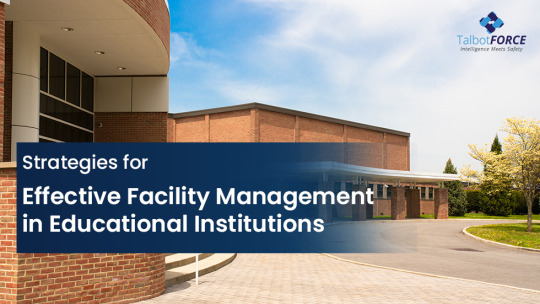TalbotFORCE is new-age facility management and disinfection service provision company, a one-stop solution to all your organizational needs within modern services portfolio for our customers across several industries & reputed clients.
Don't wanna be here? Send us removal request.
Text
To 5 Effective Cleaning Techniques for Hazardous Manufacturing Environments
In the world of manufacturing, where precision and productivity are paramount, ensuring cleanliness is not just a matter of aesthetics—it's a critical component of safety and compliance, particularly in hazardous environments. From chemical spills to airborne contaminants, these settings pose unique challenges that demand meticulous attention to cleaning practices.

Let’s delve into the importance of effective cleaning techniques in hazardous manufacturing environments and explore strategies to maintain cleanliness while mitigating risks.
1. Chemical Management and Dilution
Within manufacturing processes, chemicals play a pivotal role, yet their improper handling or disposal can pose substantial risks to both workers and the environment. Establishing stringent chemical management protocols is imperative for maintaining safety standards. This includes meticulous labelling, storage, and handling of chemicals, alongside the integration of dilution systems to regulate concentrations and mitigate exposure. Through diligent chemical management practices, manufacturers can effectively minimize the likelihood of accidents and contamination, thus fostering a safer working environment for all.
2. High-Pressure Water Cleaning
High-pressure water cleaning proves to be a highly efficient method for eliminating persistent residues, oils, and contaminants from both equipment and surfaces within hazardous manufacturing environments. By harnessing the force of pressurized water, this technique effectively removes and flushes away dirt and debris, offering a comprehensive and swift cleaning solution. Nonetheless, it's imperative to exercise meticulous control over water pressure levels to safeguard against potential damage to equipment and surfaces, all while prioritizing the safety of workers.
3. Dry Ice Blasting
Utilizing solid carbon dioxide (dry ice) pellets, dry ice blasting emerges as a non-abrasive cleaning method to eradicate contaminants from various surfaces. Especially suitable for delicate machinery, electrical components, and sensitive equipment within hazardous environments, this technique stands out for its ability to ensure thorough cleaning without leaving behind secondary waste or chemical residues. Known for its environmental friendliness, non-conductivity, and non-toxic nature, dry ice blasting presents itself as a safe and effective cleaning solution for manufacturing facilities.
4. Chemical Solvent Cleaning
In cases where stubborn residues or contaminants cannot be removed through other methods, chemical solvent cleaning may be necessary. However, it's essential to use caution and select appropriate solvents that are compatible with the materials being cleaned and safe for use in the manufacturing environment. Proper ventilation and personal protective equipment (PPE) should also be utilized to minimize exposure risks for workers. Additionally, manufacturers should adhere to regulatory guidelines and disposal protocols for hazardous waste generated during solvent-cleaning processes.
5. Automated Cleaning Systems
Automated cleaning systems are a revolutionary solution for hazardous manufacturing environments, offering unparalleled efficiency and consistency. From robotic cleaners to conveyor-based washing systems, these cutting-edge systems are engineered to carry out cleaning tasks with unmatched precision and reliability. By programming these automated solutions to handle repetitive tasks, the potential for human error is greatly reduced, resulting in improved cleanliness and safety across the board. Through the integration of automated cleaning systems, manufacturers can optimize their operations, increase productivity, and maintain compliance with stringent cleanliness standards, thereby fostering a safer and more efficient work environment.
In hazardous manufacturing environments, the implementation of effective cleaning techniques goes beyond basic hygiene—it becomes essential for safeguarding worker safety and operational integrity. Embracing these best practices enables manufacturers to cultivate a workplace that is not only safer and more efficient but also sustainable for all stakeholders involved.
0 notes
Text
Educational institutions are hubs of intellectual growth and exploration, where students embark on transformative educational journeys. Within this pursuit of academic excellence, the importance of efficient facility management cannot be emphasized enough. Facility management encompasses ensuring the safety and well-being of students, promoting sustainability, and fostering an environment conducive to innovation and learning.

0 notes
Text
Office Workstation and Cabin Cleaning Checklist
By using this comprehensive checklist for cleaning workstations and office cabins, you can establish a clean and organized work environment that enhances productivity and well-being among your employees.
Regular maintenance will help create a positive first impression for your clients and visitors, which in turn can contribute to the overall success of your business.

0 notes
Text

Revolutionizing Facility Management Through Technology
In the world of facility management, where efficiency and innovation are key, TalbotFORCE is a game-changer that blends technology with the art of facility management. Let's explore how this forward-thinking company is transforming the industry.
0 notes
Text

0 notes
Text
How Professional Cleaning Can Improve the Quality of Indoor Air

Amidst the busy routine of our daily lives, we tend to overlook the air quality inside our homes or workplaces.
However, it is crucial to understand that indoor air quality plays a significant role in our health, productivity, and overall well-being.
0 notes
Text
Strategies for Effective Housekeeping Plan for the Hospitality Industry

A successful housekeeping plan is crucial for the hospitality industry since it directly affects guest satisfaction, safety, and the overall reputation of the establishment.
A well-organized and carefully executed housekeeping strategy ensures that guest rooms and common areas meet high cleanliness standards, contributing to a positive guest experience.
This fosters guest loyalty, positive reviews, and repeat business.
0 notes
Text
As we bid farewell to 2023, the facility management industry stands as a testament to transformation and growth amid evolving consumer and business preferences.
This year marked a pivotal shift towards a holistic approach, where tangible business spaces are integrated seamlessly with cutting-edge technology to enhance user experiences and operational efficiencies.
0 notes
Text
Tech Trends: The Latest in Office Security Technology
Imagine a world where visitors breeze through check-in, their faces instantly recognized and verified by a system. This is the promise of facial recognition in visitor management systems (VMS). This technology uses algorithms to map unique facial features, streamlining entry and boosting security.

For visitors, it's a touchless, convenient experience. No more waiting, filling forms, or carrying badges. Simply approach the kiosk, and the system grants access if authorized. For organizations, it's a security upgrade. Facial recognition helps identify unauthorized individuals, track visitor movement, and even detect known threats.
0 notes
Text
youtube
Facility Management needs to be sustainable as it positions organizations for a resilient & responsible future. From cutting-edge technology to eco-friendly practices, sustainable facility management has a whole world of #possibilities that need to be unveiled.
Our CEO, Manu Sethi, sheds some light on how organizations can adopt an environment-friendly approach while streamlining their management.
1 note
·
View note
Text
Unveiling Secrets for a Spotless Restaurant
Maintaining cleanliness in a restaurant can be a challenging task, especially with a constant stream of customers, vendors, and workers visiting every day.

Given that restaurants are high-traffic areas, it is crucial to keep them clean to ensure customer satisfaction and maintain health and safety standards.
Read for click below
Cleaning and Hygiene Tips for Restaurants
1 note
·
View note
Text
Security Guards Secure Our World and Keep us Safe
Security guards are the unsung heroes of the modern world. They tirelessly work to ensure our safety and protect us from harm. Their presence alone provides a reassuring sense of security, and their unwavering vigilance keeps danger at bay. Without them, our world would be a much more dangerous place.

So let's take a moment to appreciate the security guards who keep us safe, day in and day out.
Security Guards
0 notes
Text

Pre-Diwali Office Cleaning Tips by TalbotFORCE
With Diwali just around the corner, workspaces across the country are gearing up for the festivities. From colorful decorations and intricate Rangoli to the sweet aroma of traditional sweets, the festival of lights brings a joyous atmosphere to the workplace.
However, before you get swept up in the excitement, it's important to ensure that your office is clean and well-maintained. A spotless workspace not only boosts employee morale but also creates a positive impression on visitors.
With that in mind, take the time to tidy up your office and make it a welcoming environment for everyone to enjoy.
0 notes
Text
Role of Housekeeping Service in Retail Industry
Housekeeping services play a critical role in maintaining cleanliness and hygiene. These services are not just limited to cleaning but also include organizing inventories, ensuring safety measures, maintaining restrooms, managing waste, and providing customer assistance. Additionally, housekeeping services provide support for visual merchandising to enhance the overall customer experience.

0 notes
Text
Having a clean and well-maintained environment is crucial for any commercial building. Hence, the significance of janitorial services cannot be underestimated. Janitorial services are essential to ensure that the building is hygienic, presentable, and safe for occupants.
By providing regular cleaning, dusting, and disinfecting services, janitors can help prevent the spread of diseases and ensure that the building's interior and exterior are aesthetically pleasing.
Additionally, a clean and well-maintained environment can enhance the reputation of the building and create a positive impression on visitors. Therefore, it is essential to invest in reliable janitorial services to maintain the cleanliness and hygiene of commercial buildings.
0 notes
Text
Sweeping Success: Leave the cleanliness task to Our Cleaning Service Experts
A clean workspace is among the most underrated contributors to business growth. Neat & tidy workspaces can ensure health & well-being & help in better order & organization, making most of the management seamless.
Cleaning for any space may need many services on a timely basis; the first & most important is Janitorial services, which are solely responsible for day-to-day cleaning & maintenance.
Read more
0 notes
Text

Prioritizing Safety: Commitment to Everyone’s Protection
It's important to understand one important factor in today's fast-paced world where organizations are continuously aiming for growth and success: safety. The security of your assets and the welfare of your workforce are of the utmost importance to TalbotFORCE.
0 notes